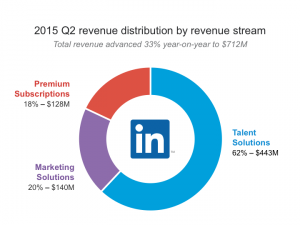Linkedin Recruiter Spam and you: LinkedIn has a candidate experience problem
LinkedIn solved a real market inefficiency in hiring. By mapping the professional networks of millions of people worldwide in the 200s, they lowered the barrier to search for talent by skill, connection, or location in a really really useful way. They were able to monetize the data they had on professional networks because by lowering the barrier to search for employees, they lowered the cost for businesses to source employees.
LinkedIn is a free website; So where does it’s massive $712M in quarterly revenue come from?
Through selling access to talent!
And companies are buying! LinkedIn is used for recruiting by 93% of companies! LinkedIn is massively useful to achieve access to talent.
The candidate experience problem
Although LinkedIn is massively useful for businesses, it is only marginally useful for job-seekers. That’s because it’s really hard to recruit on LinkedIn without being a a SPAMMER. The signal-to-noise ratio is low, and it’s because recruitment unit economics just don’t make a case for customizing every message.
In the circles I run in, that has soured LinkedIn’s reputation. The word of mouth reputation of LinkedIn’s services is at an all time low.
@semanticist have you got anything of value from LinkedIn? Collecting data for my scientific study, sample size 1.
— Adam Millerchip (@amillerchip) October 20, 2015
Dear recruiter, You know what’s more “rare” than this “exciting opportunity”? A spam email sent to everyone on LinkedIn that doesn’t suck.
— Po (@polina_giralt) October 12, 2015
The recruiter #spam has to stop on @LinkedIn. They don’t realize thatwe are the product they’re selling to recuiters https://t.co/3Evl6nuwCN — Ross Raphael (@RossingtonDC) October 7, 2015
How to Solve the Candidate Experience Problem
LinkedIn makes money off of selling access to the massive droves of job-seekers in their database. That means if you sign up for an account at LinkedIn, you are the product being sold. In a way, that’s okay, because recruitment is a good thing. But the tactics employed on LinkedIn in 2015 are *bad* for everyone but the recruiter.
- As a LinkedIn member, I want to be alerted to experiences that are *uniquely appropriate for my career path*.
- As a company that’s hired a recruiter, I want my brand to be respected, and I want the *best* candidates for the job.
Check out these samples of LinkedIn messages. Do they meet either of these needs? NO.
In order to solve these problems, LinkedIn needs to fully revamp the Candidate Experience. I think that in order to solve that problem, LinkedIn needs to invest in two things:
- Improving Data Quality
- Disincentivize Spam with Easy To Use Automated Messaging Flows
What’s at Stake?
Social platforms are only as good as the value they provide to end users. For these platforms, the value provided is strongly associated with the value of the lowest common denominator interaction they produce.
So will this candidate experience problem affect LinkedIn’s share price?
My thesis is that, if User Experience is King, users will eventually start ignoring LinkedIn messages, and this will cause attrition to LinkedIn’s userbase (and subsequently, to their revenue and eventually share price) over the long term.
Why Improve Data Quality?
Profile Quality
LinkedIn’s recruiter tools don’t distinguish between strong connections or weak connections. They don’t distinguish between skills I have been honing for 10 years or 10 minutes. In order to invest in data quality, LinkedIn needs to find a way to classify:
- Which of my connections are *strong* connections? Which have I just met in passing?
- Which of my skills are *strong* skills?
- How many years of experience do I have?
Message Quality
Of the messages a candidate receives from a recruiter, there needs to be a disincentive to SPAM. Tilt the unit economics on the platform away from spamming. Here’s how StackOverflow does it. From their FAQ:
> Why can I only have 20 outstanding messages?
Limiting the number of outstanding messages helps us control spam sent to candidates and encourages employers to keep messages relevant to a candidate’s interest, experience and qualifications. Once a candidate replies, or after 7 days if they do not reply, a message spot is freed up.
How can LinkedIn Disincentivize Spam with Easy To Use Automated Messaging Flows?
Automated Search & Messaging Tools
Recruiters use Automation to perform outreach. That’s an okay thing, because it’s efficient. What’s not okay is when efficiency means a loss of quality and a candidate receives a message that is not plausibly relevant to them.
In order to solve the SPAM problem, messages needs to pass the following cold outreach litmus test:
- Message is personalized (beyond first name).
- Sender mentions a common interest or connection.
- Sender clearly read my blog, or my github.
- Sender sounds like a human, not a corporate PR robot.
- Pitch is targeted towards plausible next steps in growth of my personal career (skills, experience level, location).
This can all be automated using data quality tools.
- 1, 2, & 3 — LinkedIn knows my twitter handle, github, website, facebook address, and can pull interests and connedctions from them.
- 4 — LinkedIn can templatize messages to provide a different “voice” for each vertical or skill set. If a recruiter is targeting enterprisey folks, they can dress up the message. If they are targeting startups, they can dress them down.
- 5 — Since LinkedIn knows how many years experience I have, it can target outreach emails to only my experience level.
If it can’t be automated or the candidate is not a plausible target for the position in question, then it is important that LinkedIn does *NOT* allow automated delivery of the message. Instead, it could provide the recruiter an option to efficiently *manually customize the message*.
